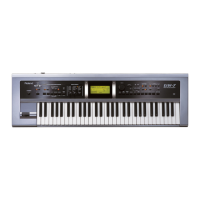4
Roland GW-7 MIDI Implementation
●
Reset All Controllers (Controller number 121)
Status
2nd byte 3rd byte
BnH 79H 00H
n = MIDI channel number: 0H - FH (ch.1 - 16)
* When this message is received, the following controllers will be set to their reset values.
Controller
Reset value
Pitch Bend Change +/-0 (center)
Polyphonic Key Pressure 0 (off)
Channel Pressure 0 (off)
Modulation 0 (off)
Expression 127 (max)
Hold 1 0 (off)
Portamento 0 (off)
Sostenuto 0 (off)
Soft 0 (off)
RPN unset; previously set data will not change
NRPN unset; previously set data will not change
●
All Notes Off (Controller number 123)
Status
2nd byte 3rd byte
BnH 7BH 00H
n = MIDI channel number: 0H - FH (ch.1 - 16)
* When All Notes Off is received, all notes on the corresponding channel will be turned
off. However, if Hold 1 or Sostenuto is ON, the sound will be continued until these are
turned off.
●
OMNI OFF (Controller number 124)
Status
2nd byte 3rd byte
BnH 7CH 00H
n = MIDI channel number: 0H - FH (ch.1 - 16)
* The same processing will be carried out as when All Notes Off is received.
●
OMNI ON (Controller number 125)
Status
2nd byte 3rd byte
BnH 7DH 00H
n = MIDI channel number: 0H - FH (ch.1 - 16)
* The same processing will be carried out as when All Notes Off is received. OMNI ON
will not be turned on.
●
MONO (Controller number 126)
Status
2nd byte 3rd byte
BnH 7EH mmH
n = MIDI channel number: 0H - FH (ch.1 - 16)
mm = mono number: 00H - 10H (0 - 16)
* The same processing will be carried out as when All Sounds Off and All Notes Off is
received, and the corresponding channel will be set to Mode 4 (M = 1) regardless of the
value of “mm (mono number)”.
●
POLY (Controller number 127)
Status
2nd byte 3rd byte
BnH 7FH 00H
n = MIDI channel number: 0H - FH (ch.1 - 16)
* The same processing will be carried out as when All Sounds Off and All Notes Off is
received, and the corresponding channel will be set to Mode 3.
■
System Realtime Messages
●
Timing Clock
Status
F8H
* When “Timing Clock” is received, the internal song/style player is synchronized to an
external clock according to the following table.
System: Sync Rx Response
OFF (Internal) A Song/Style will neither start/stop nor follow the tempo of the
external “Timing Clock” (F8) and “Start/Stop” (FA/FC) messages.
ON (Auto) If a Song/Style receives “Start/Stop” (FA/FC), it will follow
automatically Internal or External Timing related to the presence or
not of the incoming “Timing Clock” (F8) messages.
●
Song/Style Start
Status
FAH
* When “Start” is received, the internal song/style player start.
●
Song Continue
Status
FBH
* When “Continue” is received, the internal song player continue to play from the current
position.
* Received only in Song Mode.
●
Song/Style Stop
Status
FCH
* When “Stop” is received, the internal song/style player stop.
●
Active Sensing
Status
FEH
* When “Active Sensing” is received, the unit will begin monitoring the intervals of all
further messages. While monitoring, if the interval between messages exceeds 420 ms,
the same processing will be carried out as when All Sounds Off, All Notes Off and Reset
All Controllers are received, and message interval monitoring will be halted.
■
System Common Message
●
Song Position Pointer
Status 2nd byte 3rd byte
F2H llH hhH
ll = song position LSB: 00H - 7FH
hh = song position MSB: 00H - 7FH
* Not received when System: SongPos TxRx = OFF. (Initial value is ON)
* Received only in Song Mode.
■
System Exclusive Messages
Status
Data byte Status
F0H iiH, ddH, ......,eeH F7H
F0H: System Exclusive Message status
ii = ID number: an ID number (manufacturer ID) to indicate the manufacturer whose
Exclusive message this is. Roland’s manufacturer ID is 41H.
ID numbers 7EH and 7FH are extensions of the MIDI standard; Universal Non-realtime
Messages (7EH) and Universal Realtime Messages (7FH).
dd,...,ee = data: 00H - 7FH (0 - 127)
F7H: EOX (End Of Exclusive)
The System Exclusive messages received by the GW-7 are: messages related to mode
settings, Universal Realtime System Exclusive messages and Data Set (DT1).
●
System Exclusive messages related to mode settings
These messages are used to initialize a device to GS or General MIDI mode, or change the
operating mode. When creating performance data, a “GM1 System On” message should be
inserted at the beginning of a General MIDI 1 score, a “GM2 System On” message at the
beginning of a General MIDI 2 score, and a “GS Reset” message at the beginning of a GS
music data. Each song should contain only one mode message as appropriate for the type of

